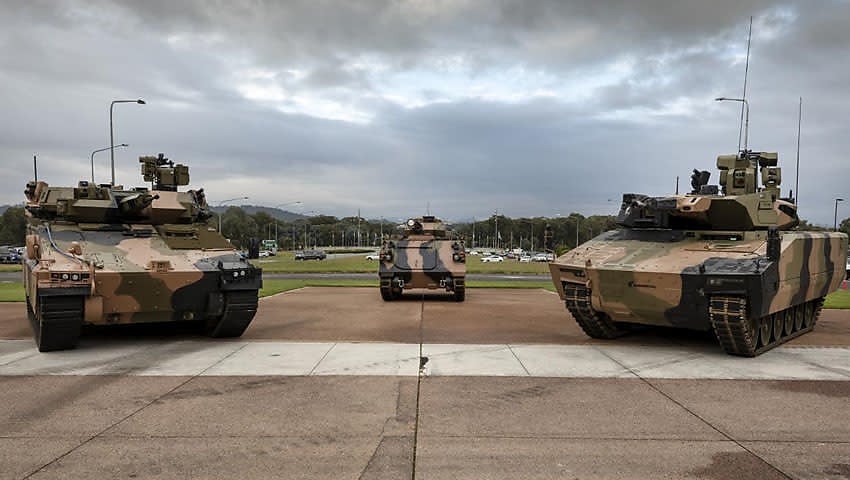Are Australia’s future infantry fighting vehicles fundamental to the ADF’s warfighting success?
To continue reading the rest of this article, please log in.
Create free account to get unlimited news articles and more!
Two final contenders await a Commonwealth government decision on the $18-27 billion LAND 400 Phase 3 contract — Rheinmetall Defence Australia (RDA) and Hanwha Defense Australia (HDA).
The global defence primes are bidding to supply and support up to 450 next-generation infantry fighting vehicles (IFVs) for the Australian Army.
The new vehicles will replace the existing fleet of M113 armoured personnel carriers, which have been in service since the mid-1960s.
The IFVs are expected to enable Army to sustain mounted close combat operations against emerging and future threats as part of a joint force.
The request for tender was released to industry on 24 August 2018, with Defence seeking an IFV with high levels of protection, mobility and lethality, capable of lifting six dismounts in a standard infantry battalion section.
Defence also noted its preference for a tracked vehicle with a manned turret.
RDA’s Lynx IFV and HDA’s Redback IFV emerged as the finalists after a review process.
Both vehicles have completed a two-year risk mitigation activity (RMA), and now await a final Commonwealth government decision.
The decision is imminent, with Defence Connect recently informed a recommendation on the preferred tender “remains on schedule to be considered by government this year”.
According to Albert Palazzo — an adjunct professor at the University of NSW, Canberra — the government’s ultimate decision would play a critical role in determining the Australian Defence Force’s (ADF) future posture.
“These heavily protected and well-armed vehicles sit at the heart of the army’s future combined-arms system, which will help enable the ADF to fight as a joint integrated force rather than as three separate services,” he writes in ASPI’s The Strategist.
Palazzo dismisses criticism of Australia’s prioritisation investment in land combat capability amid changes to the nature of warfighting.
“The assertion that a single vehicle, such as the IFV, is so central to how the ADF will fight in the future may strike some as an exaggeration. It is not,” he continues.
“The infantry fighting vehicle goes to the heart of what war has always been and what it will remain — a contest between people and the land on which they live. Whether Australia finds itself in a future insurgency-style war, similar to Afghanistan, or a more intensive struggle, such as that in Ukraine, control of people and the land they live upon is the constant.”
Palazzo acknowledges evolving threats posed by advancements in strike capability but stresses the continued importance of land combat in determining the outcome of an armed conflict.
There’s no doubt that long-range missiles, drones, submarines and long-range bombers are useful and necessary platforms,” he writes.
“However, distant strike, ubiquitous sensing and cyber-driven operations exist to achieve what continues to determine war’s outcome: soldiers closing with their adversary, seizing ground and giving them no choice but to accept defeat.
“This requires personnel on the ground, and IFVs will provide the battlefield protection and mobility they need to exert force over the enemy.”
Reflecting on the vehicles proposed for LAND 400 Phase 3 — Hanwha’s Redback and Rheinmetall’s Lynx — Palazzo claims the vehicles represent a “generational leap in technological capability”.
He compares Army’s transition to the IFVs to the Royal Australian Air Force’s (RAAF) shift from a fourth- to a fifth-generation force with the acquisition of the F-35A Lightning II aircraft.
In a newly released ASPI special report — Deciding the future: The Australian Army and the infantry fighting vehicle — Palazzo also identifies existing gaps and opportunities Defence should address to achieve maximum utility from the future IFVs.
“For example, the ADF has traditionally undervalued logistics, which will have an effect on the operational deployment and sustainment of these vehicles. There are solutions to present logistic gaps or offsets that can be leveraged,” he observes.
“Still the government needs to recognise, as the report points out, that optimising the ADF’s combat capability will necessitate additional investment, not just in logistics, but also in armed and counter-drone systems, local ammunition manufacturing and further integration with the other services.”
As such, Palazzo argues the IFVs are not a “stand-apart capability”, but both “need and create links across the entire force”.
He goes on to draw from developments throughout the Russia-Ukraine conflict, claiming Russia’s failure to employ “properly trained troops, decent leadership, effective logistics and up-to-date platforms” have produced “abysmal” outcomes for the military.
Palazzo concludes by stressing Australia must build a “more robust and powerful” force to manage evolving threats, with the IFVs representing an “investment in army capability for a more dangerous age”.
“As Deciding the future maintains, it is now up to the government to determine the extent and direction of that investment,” he writes.
Get involved with the discussion and let us know your thoughts on Australia’s future role and position in the Indo-Pacific region and what you would like to see from Australia's political leaders in terms of partisan and bipartisan agenda setting in the comments section below, or get in touch with

 Login
Login







